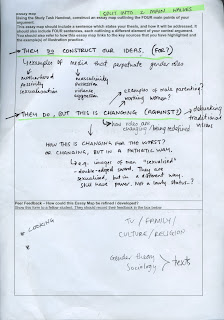This was my very first essay plan for my chosen question on gender. I had almost everything in mind such as the images and sources I would use. However after the feedback I realised the ideas I had formed up to that point were very vague and had little direction. I needed to revisit the question, and refine the information I had gathered and go from there.
Peer feedback
• Find more examples of adverts where typical gender roles are subverted
• Look at the extremity of perpetuating gender roles
• Think about why these roles are presented - where the values come from
"To what extent does advertising construct our ideas of gender"
I think with this question it would be easy to veer off into many different subjects, or magnify one aspect far too much and ignore all of the others.
What to do next
• List and examine 'gender roles' and other ideas on gender - what they are, what roles exist, why?
• Find adverts that endorse or reflect these ideas
• Look at sources that address the relationship between advertising and gender, its effects on us as people, HOW it informs our concepts of gender.
• Look at sources that may explain the ORIGINS of our ideas on gender; e.g. what is masculinity? why is something considered masculine/feminine?


